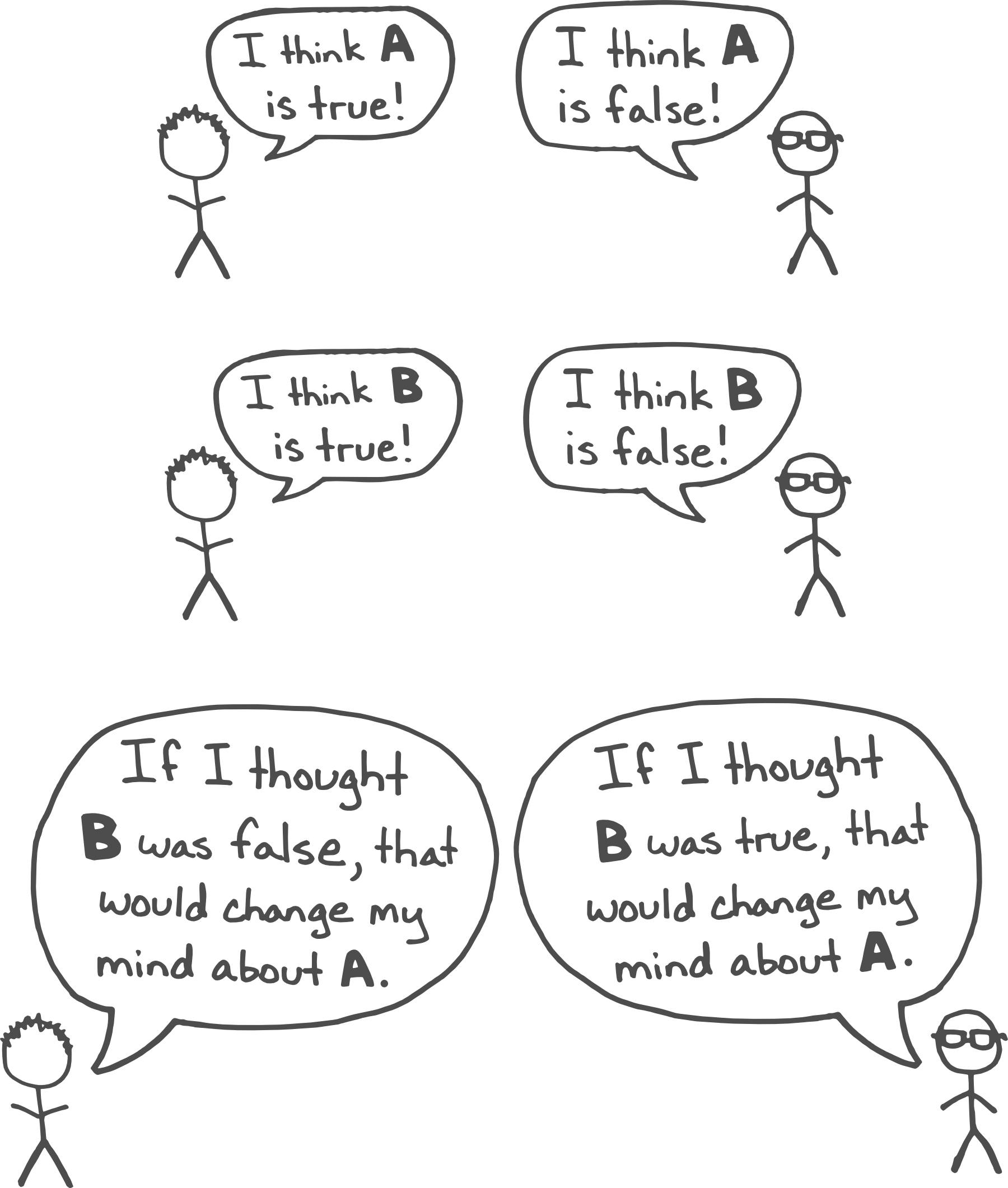...uplinks, including horizontal links to competitors or antipatterns
- Internal double crux {IDC 'feels' to MOB more like a downlink, but a case can prob be made for it being an uplink? best uplink case feels like it'd be something like: do it with yourself before doing it with others...
pedagogical priority}
Interpersonal disagreements signal the need to reveal the underlying structure of beliefs.

Typically, when two people argue, they aren't trying to find truth—they're trying to win.
If you're trying to win, you're incentivized to obscure the underlying structure of your beliefs. You don't want to let your opponent know where to focus their energy, to more efficiently defeat you. You might, for instance, bury your true crux in a list of eleven supporting points, hoping (whether consciously or not) that they'll waste a lot of time overturning the irrelevant ones.
Meanwhile, you're lobbing your best arguments like catapult loads over at their tower-of-justifications, hoping to knock out a crucial support.
This process is wasteful, and slow! You're spending the bulk of your processing power on modeling their argument, while they try to prevent you from doing so.
Sometimes, this is the best you can manage. Sometimes you do indeed need to play to win.
But if you notice that this is not actually the case—if you realize that the person you're talking to is actually reasonable, and reasonably willing to cooperate with you, and that you just slid into an adversarial mode through sheer reflex—you can both recoup a tremendous amount of mental resources by simply changing the game.
After all, you have a huge advantage at knowing the structure of your own beliefs, as they do at knowing theirs! If you're both actually interested in getting to the truth of the matter, you can save time and energy by just telling each other where to focus attention.
Longer paragraphs discussing the solution. Discussion of when the solution is appropriate.
The actual victory condition for double crux isn’t the complete resolution of the argument (although that can and does happen). It’s agreement on a shared causal model of the world—in essence, you’ve won when both you and your partner agree to the same if-then statements.
(e.g. you both agree that if uniforms prevent bullying, then schools should have them, and if they do not, then schools should not.)
To get there, you and your partner need to find a double crux—a belief or statement that is a crux for you and for your partner. More formally, if you and your partner start by disagreeing about the truth of statement A, then you’re looking for a statement B about which you also disagree, and which has the potential to influence either of you to change your mind about A.
The Double Crux algorithm
1. Find a disagreement with another person
- A case where you believe one thing and they believe the other
- A case where you and the other person have different confidences (e.g. you think X is 60% likely to be true, and they think it’s 90%)
2. Operationalize the disagreement
- Define terms to avoid getting lost in semantic confusions that miss the real point
- Find specific test cases—instead of (e.g.) discussing whether you should be more outgoing, instead evaluate whether you should have said hello to Steve in the office yesterday morning
- Wherever possible, try to think in terms of actions rather than beliefs—it’s easier to evaluate arguments like “we should do X before Y” than it is to converge on “X is better than Y.”
3. Seek double cruxes
- Seek your own cruxes independently, and compare with those of the other person to find overlap
- Seek cruxes collaboratively, by making claims (“I believe that X will happen because Y”) and focusing on falsifiability (“It would take A, B, or C to make me stop believing X”)
4. Resonate
- Spend time “inhabiting” both sides of the double crux, to confirm that you’ve found the core of the disagreement
- Imagine the resolution as an if-then statement, and use your inner sim and other checks to see if there are any unspoken hesitations about the truth of that statement
5. Repeat!
Therefore:
Hold interpersonal conversations in the double crux style in order to create common knowledge around the structure of the parties' belief systems. Seek to define terms and remove verbal ambiguity, to uncover the why of your disagreement, and to find places where either of you can potentially learn from the other.
downlinks
- Internal Double Crux {if the organizing principle is eg
number of peoplethen IDC would be down, because in DC you're dealing with 2 or more people and in IDC only one person. although you might have any number of internal agents in disagreement, so could be argued.}